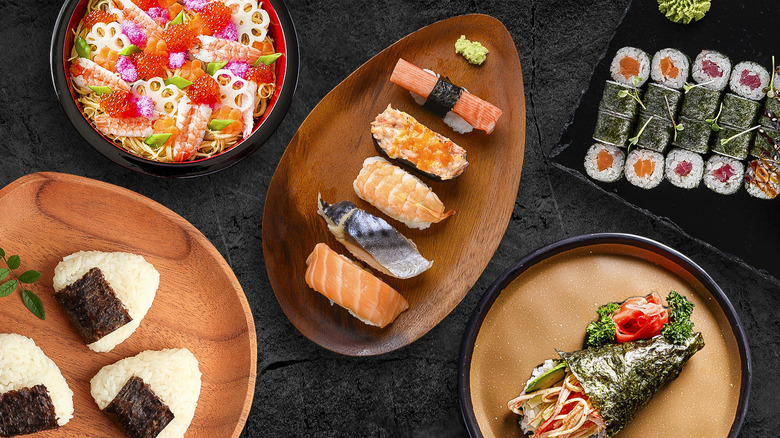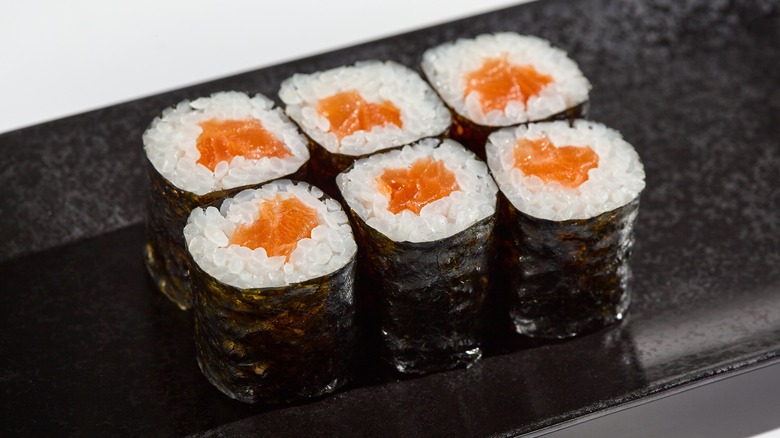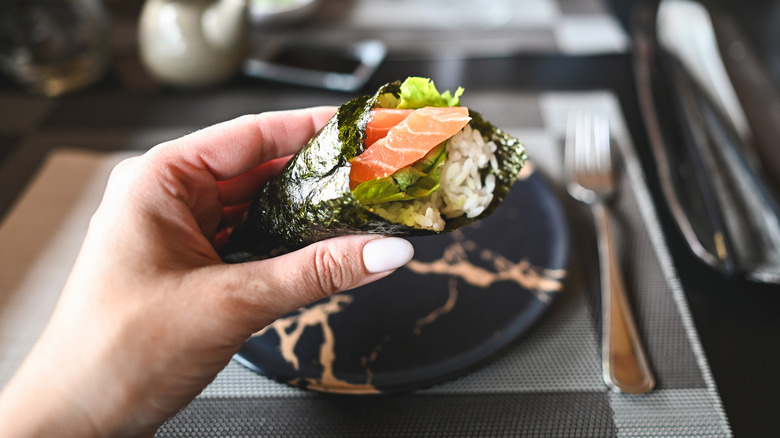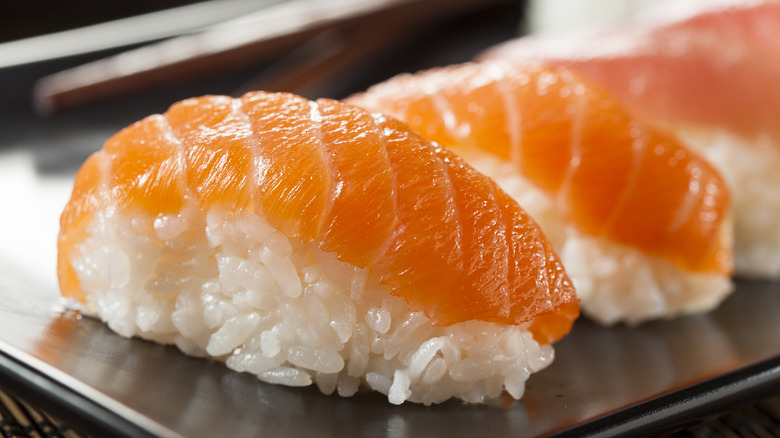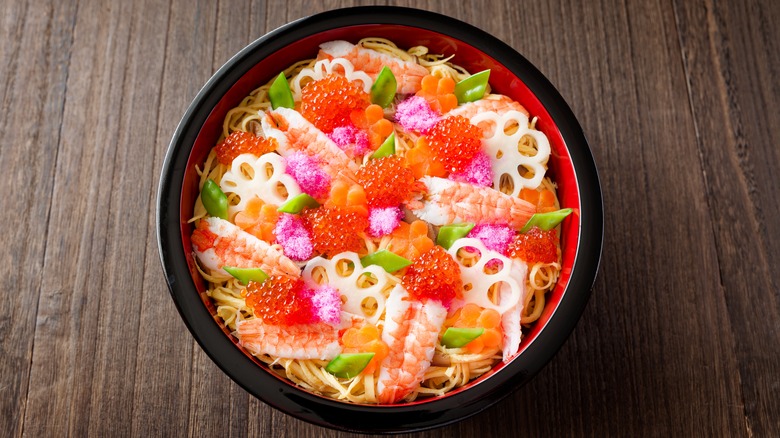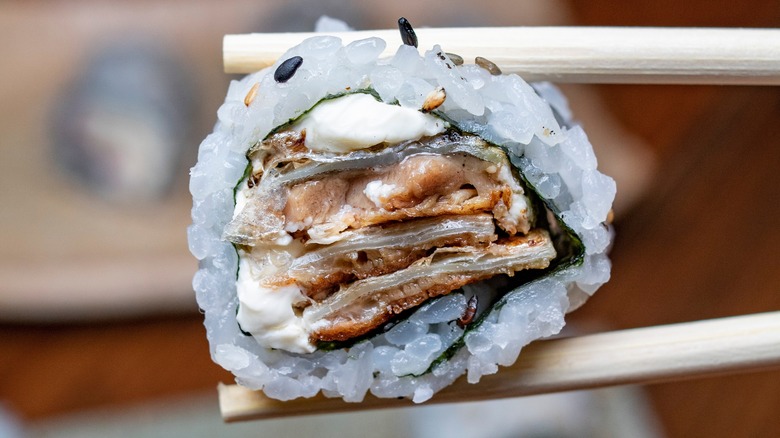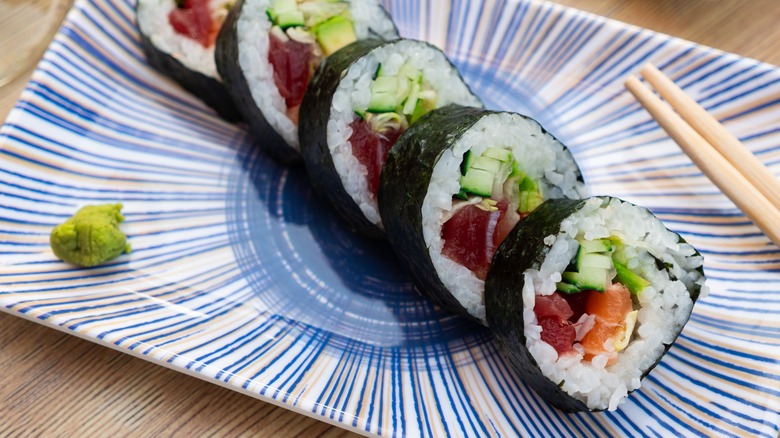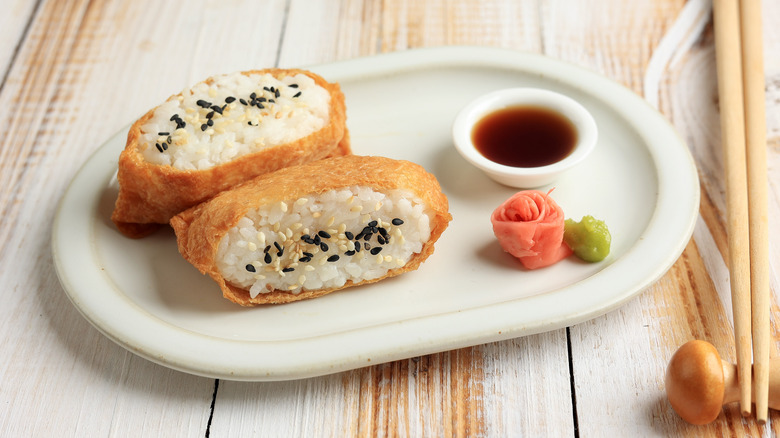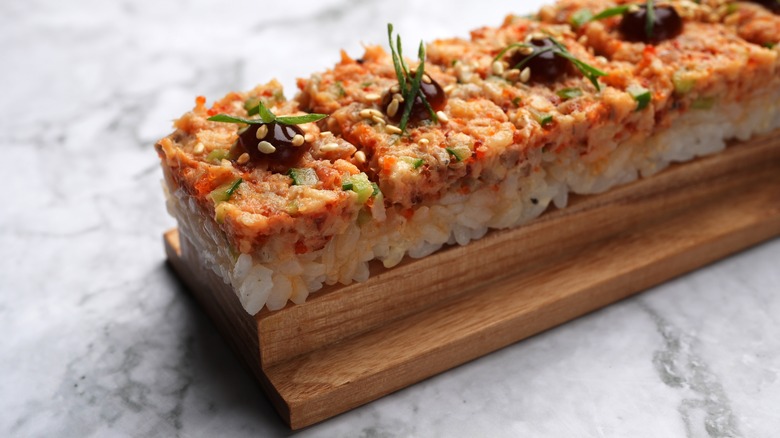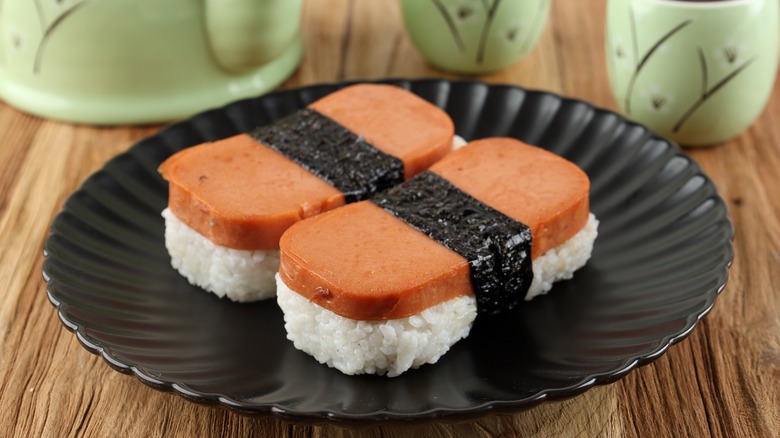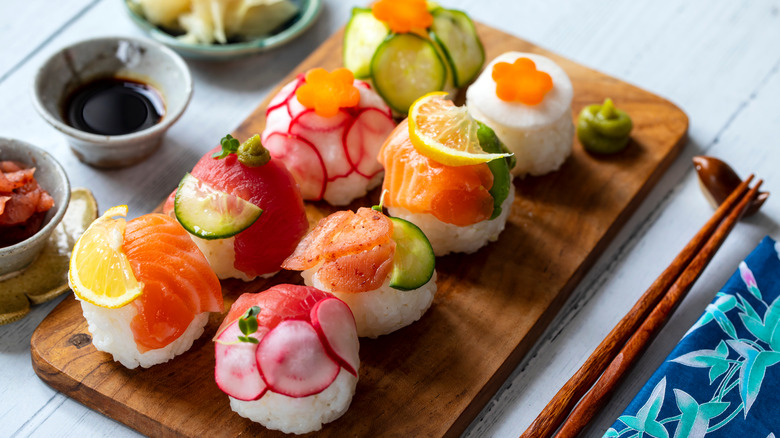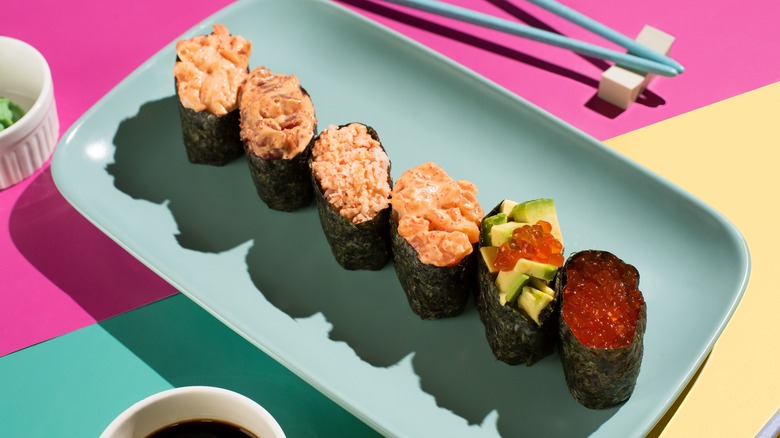11 Types Of Sushi, Explained
Sushi is up there as a favorite meal for many. After all, what's not to love about its light, fresh flavors and elegant presentation? It's a dish that's widely associated with Japanese cuisine (it actually originated in Southeast Asia) but is now found in restaurants, supermarkets, food stalls, and home kitchens all over the world.
While you might recognize sushi as the simple pairing of seasoned rice and fish, often dunked into a little bowl of umami-rich soy sauce, there's actually far more to sushi than you'd first assume. From delicate slices of sashimi and bite-sized bundles of nigiri to fried inari pouches, there are so many variations to try. The art of sushi-making includes rolls, wraps, pressed bites, and even deconstructed bowls brimming with color and crunch.
So, join us as we explore the incredible diversity that the world of sushi has to offer. For each sushi variation, we'll take a look at how it's prepared, what the key ingredients are, and what makes it unique. Familiarize yourself with these beautifully crafted dishes, and next time you're browsing the menu at your favorite sushi restaurant, you'll be ordering with a new-found confidence.
1. Hosomaki
Hosomaki, the simplest of sushi rolls, is perhaps what most of us picture as classic sushi. Its name is derived from the Japanese words "hoso" (meaning thin) and "maki" (meaning roll), which describes its shape to a tee. Hosomaki generally features a single filling wrapped in a thin layer of seasoned rice and encased in nori (seaweed). The rolls tend to be about an inch in diameter, so this type of sushi is perfectly bite-sized and easy to enjoy.
With this minimalistic sushi dish, the single-filling ingredient's taste can be highlighted, without the interference of any overly strong flavors. Popular fish choices for hosomaki include tuna and salmon, while veggie options are common too, such as cucumber or pickled radish.
Despite its modest appearance, preparing hosomaki still requires skill. Typically, a half sheet of nori is used for these smaller rolls. The rice must be evenly spread onto the nori sheet, at just the right thickness to maintain that classic slender roll shape and ensure it doesn't overpower the filling. Hosomaki is often served as an appetizer or as part of a mixed sushi platter, serving as a refreshing and easy-to-eat contrast to larger, more complex rolls. If you're new to sushi, these compact rolls are an excellent place to start!
2. Temaki
Temaki is a little different than other types of maki sushi, with a rather appealing cone-like shape. Meaning "hand roll", temaki presents a more casual, hands-on eating experience, compared to tightly rolled hosomaki or neatly assembled nigiri. This dish usually consists of an outer sheet of nori, filled with vinegared rice, seafood, vegetables, and sauces, and rolled up into a large cone.
This type of sushi is known for its customizability, with plenty of scope to experiment with different fillings. Common combinations include fresh tuna with cucumber, salmon and avocado, or shrimp tempura paired with creamy mayonnaise and lettuce. The cone shape makes it easy to hold and eat, and its open structure means more room for fillings, so it's a great opportunity to combine multiple complementary flavors and textures.
Temaki has to be one of the best types of sushi to make with friends or family, where each person can create their own filling combination from a variety of fresh ingredients laid out on the table. When making this dish, it's important to note that the rolls are best enjoyed immediately after assembly. Waiting too long can result in soggy seaweed, so roll at the last minute to maintain that delicious crisp nori texture.
3. Nigiri
Another icon in the sushi landscape, nigiri is simple, elegant, and pleasingly bite-sized. This type of sushi consists of a small, hand-formed mound of seasoned rice, topped with a slice of raw fish or another type of seafood.
The key to perfect nigiri is achieving the right balance between the rice and toppings. Ideally, the rice mound should be about two inches long and one inch wide, while the topping should be thinly sliced, yet slightly longer and wider than the rice so it drapes over the sides of the mound. Some classic topping options are tuna, salmon, shrimp, and unagi (eel), and sometimes, a small dab of wasabi is placed between the rice and the fish to enhance the flavor. Nigiri can also be served with a thin band of nori around it, to hold less stable toppings in place, such as scallops.
When it comes to the rice, it should have just the right balance of fluffiness and stickiness so it can hold its shape. It's seasoned lightly with a combination of rice vinegar and sugar, with the slight sweetness and tang complementing the delicate, savory fish perfectly. Nigiri is great for dipping, often served alongside soy sauce, wasabi, and pickled ginger. Plus, if you're not particularly adept with chopsticks, there's good news — the traditional way to eat it is with your hands.
4. Chirashi
Unlike the neatly rolled or molded forms, chirashi (meaning "scattered sushi") is a distinctly different take on traditional sushi. This vibrant bowl of seasoned sushi rice is topped with a variety of seafood, vegetables, and garnishes. Chirashi is popular for its versatile nature and the abundance of flavors and textures it can deliver.
Often enjoyed during special occasions or celebrations in Japan, preparing chirashi is the perfect way to showcase an array of seasonal fish and toppings. You'll often see it topped with slices of tuna, salmon, crab, tamago (a Japanese sweet egg omelet), cucumber, and snow peas. The dish may also feature fish roe for pops of salty flavor, and lotus root carved into impressive floral shapes. Clearly, the presentation is just as important as the taste, with each ingredient meticulously arranged to create a beautiful, colorful, and appetizing feast.
Preparing chirashi doesn't require any rolling or shaping of rice, so it's a little more approachable than other types of sushi. It's a wonderful dish for sushi lovers to experiment with at home, with the freedom to add various toppings of choice to the bed of sticky sushi rice.
5. Uramaki
Uramaki, often referred to as the inside-out roll, flips the traditional sushi roll structure on its head. Unlike other types of maki, the rice is placed on the outside and the seaweed inside. This variation is said to have originated in the United States to appeal to Western palates that were less accustomed to the taste and texture of seaweed. However, the uramaki style remains incredibly popular all over the world.
The typical construction of uramaki begins with a sheet of nori topped with an even layer of sushi rice. This is then flipped upside down, so the nori side is facing up. Next, the filling, such as salmon and cream cheese or avocado and spicy tuna, is placed in the center of the nori before everything is rolled up and sliced. The exposed rice creates a slightly sticky exterior that can be garnished with extra toppings like thinly sliced fish, vegetables, or roe.
Uramaki offers plenty of creative potential to sushi chefs and those looking to experiment with different ingredient combinations. Varieties like the California roll, which features imitation crab, avocado, and cucumber, and the shrimp and eel-filled dragon roll, are classic examples of this popular roll.
6. Futomaki
Futomaki sushi stands out as one of the largest and most colorful rolls, with its name aptly translating to "fat rolled sushi". Filled with multiple ingredients, futomaki usually features a bolder selection of flavors than the more minimalist hosomaki.
A typical futomaki roll is about two inches in diameter (double the size of a hosomaki roll) and includes fillings such as crab, salmon, unagi, tamago, cucumber, and shiitake mushrooms. The combination can be chosen not only for taste but for the balance of colors, creating a beautiful cross-section when sliced. The preparation of futomaki requires careful arrangement to ensure that each slice has a consistent distribution of ingredients. The rice layer must also be relatively thick, with the nori rolled tightly, to hold the generous mixture of fillings snuggly together. Done right, each bite of futomaki will be equally hearty and visually appealing.
During Setsubun, a Japanese festival that marks the transition between winter and spring, futomaki is traditionally enjoyed as an entire, uncut roll. When eaten whole while facing the direction deemed lucky by the zodiac for that particular year, the futomaki becomes "ehōmaki", which is said to bring good fortune. Families often accompany this tasty tradition with the act of throwing beans out of their doors, to encourage demons to leave as the good luck enters.
7. Inari
A fantastic vegetarian sushi option, inari sushi consists of seasoned rice stuffed into a pouch made of deep-fried tofu, called aburaage. The combination of the subtly sweet tofu with the tangy rice creates a wonderful mix of flavors, so it's clear to see why inari is an incredibly popular type of sushi in Japan.
To make the aburaage pouches, pressed firm tofu is first sliced into roughly half-inch rectangles. Then, the tofu is fried in a generous layer of neutral oil until it expands and becomes beautifully puffy, which creates a hollow inner layer that's perfect for stuffing with rice. After draining, the tofu pieces are then fried a second time in even hotter oil, which creates a crisp, golden-brown finish. If you don't fancy making your own aburaage, they can also be bought ready-made in many Asian supermarkets.
For the filling, the rice is usually seasoned the classic sushi way — with rice vinegar and sugar. Crumbled nori seaweed is often mixed through the rice too, before shaping it into balls and stuffing it into the tofu pockets. Some variations will add extra toppings to the rice-filled aburaage, such as salmon, avocado, beef, radish, or seaweed.
8. Oshizushi
Oshizushi is a unique type of sushi that — amazingly – has been around for over 400 years. Originating from a region of Osaka called Kansai, oshizushi's distinctive preparation involves layering sushi rice and toppings in a rectangular or square wooden mold called an oshibako. The layers are then pressed firmly, creating a compact block that is sliced into neat, bite-sized pieces.
The toppings for oshizushi can vary widely, but they typically include marinated or cooked fish such as mackerel, trout, or salmon. The fish may be paired with fresh additions like thin slices of cucumber or avocado, and garnished with toppings like fish roe or green onion. Because of the pressing process, oshizushi holds its shape well and has a dense, satisfying texture compared to other types of sushi. The pressing not only helps with the structural integrity but also enhances the melding of flavors, with the toppings becoming more concentrated, and the rice, fish, and other ingredients seemingly blending into one.
Oshizushi is an undeniably attractive form of sushi, too, with its defined layers and perfectly formed shape making it stand out alongside other simple rolls. When slicing up a freshly pressed oshizushi block, using a sharp chef's knife is essential to ensure nice clean cuts that achieve neat, perfectly formed pieces.
9. Musubi
Often classed as a form of onigiri, musubi is a specific type of sushi, that surprisingly, originated in Hawaii. The most famous version, Spam musubi, features a slice of fried or grilled Spam placed on top of a molded block of rice, wrapped together with a strip of nori. This dish is thought to have been first created by Barbara Funamura, a Japanese American living in Hawaii during World War II. It was during this time that Spam became a staple food in the country, due to its long shelf life and easy preparation.
The combination of the salty, savory flavor of the Spam and the lightly seasoned rice creates an unexpectedly delicious balance that makes Spam musubi rather moreish. For extra flavor, some recipes introduce teriyaki sauce, furikake seasoning, or egg, so you can absolutely customize this dish to your taste. Spam musubi's simple assembly and portable nature also make it an excellent snack or lunch box addition when you're on the go.
A handy tip when shaping the rice layer for musubi is to use the empty Spam can. This can be lined with plastic wrap, before spooning in the prepared sushi rice and compacting it down to completely fill the can. Then, when you lift the plastic wrap from the can, it should have a perfectly formed, rounded rectangle rice layer, ready to place the grilled spam onto.
10. Temarizushi
An elegant, ball-shaped sushi that can be customized with an array of toppings, temarizushi has a more playful feel than traditional forms. Named after the Japanese embroidered handball called a temari, this type of sushi is compact, colorful, and perfect for special occasions. Unlike rolled or pressed sushi, temarizushi is made by shaping small portions of seasoned rice into a sphere by hand and topping them with a thin layer of fish, vegetables, or other garnishes. It's a simple concept that results in a beautiful aesthetic.
You can get creative with toppings for temarizushi, and these sushi balls tend to feature a similar selection as other common sushi rolls. Slices of salmon, tuna, and shrimp are popular, as well as vegetarian options like tamago, radish, and cucumber. These are often paired with decorative accents such as microgreens or a sprinkle of sesame seeds, that make the sushi look even more incredible.
To make temarizushi, cooked and vinegared sushi rice is first rolled roughly into a ball. Then, the topping of choice can be placed onto a sheet of plastic wrap, and the rice ball layered on top. Then, wrapping the plastic around the rice and topping, the two can be shaped into a perfectly round ball. It's a fun and straightforward technique that has the added bonus of not requiring any specialist sushi-making equipment.
11. Gunkan sushi
This type of sushi gets its name from its boat-like shape, with the word gunkan translating to "war boat" in Japanese. The distinctive shape of gunkan sushi does in fact serve a specific purpose — to hold looser, smaller, or less firm ingredients that don't stick to rice easily.
Gunkan sushi usually starts with a small oval of rice, around which a strip of nori is wrapped, extending higher than the rice to form a pocket. This pocket is then filled with the various toppings, which are often delicate, finely chopped pieces of fish and vegetables. A plate of gunkan sushi might come with a selection of toppings, such as salmon roe, sea urchin, boiled corn kernels, and spicy tuna with green onions. Sometimes, the chopped seafood is dressed in a flavorful sauce, or paired with cream cheese or mayonnaise, but thankfully, the sturdy nori layer does an excellent job of holding everything securely in place.
This format offers a fantastic opportunity to sample some slightly less conventional sushi toppings since there's more room to include ingredients that would be difficult to use in rolls or nigiri. Plus, you get a little more seaweed in every bite, which adds a nice chewiness and extra briny flavor.
